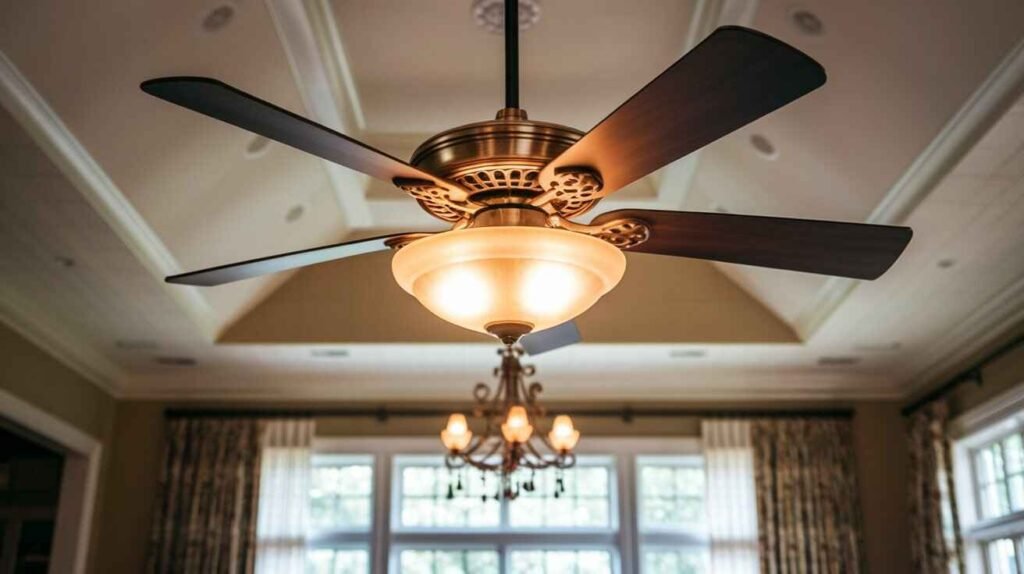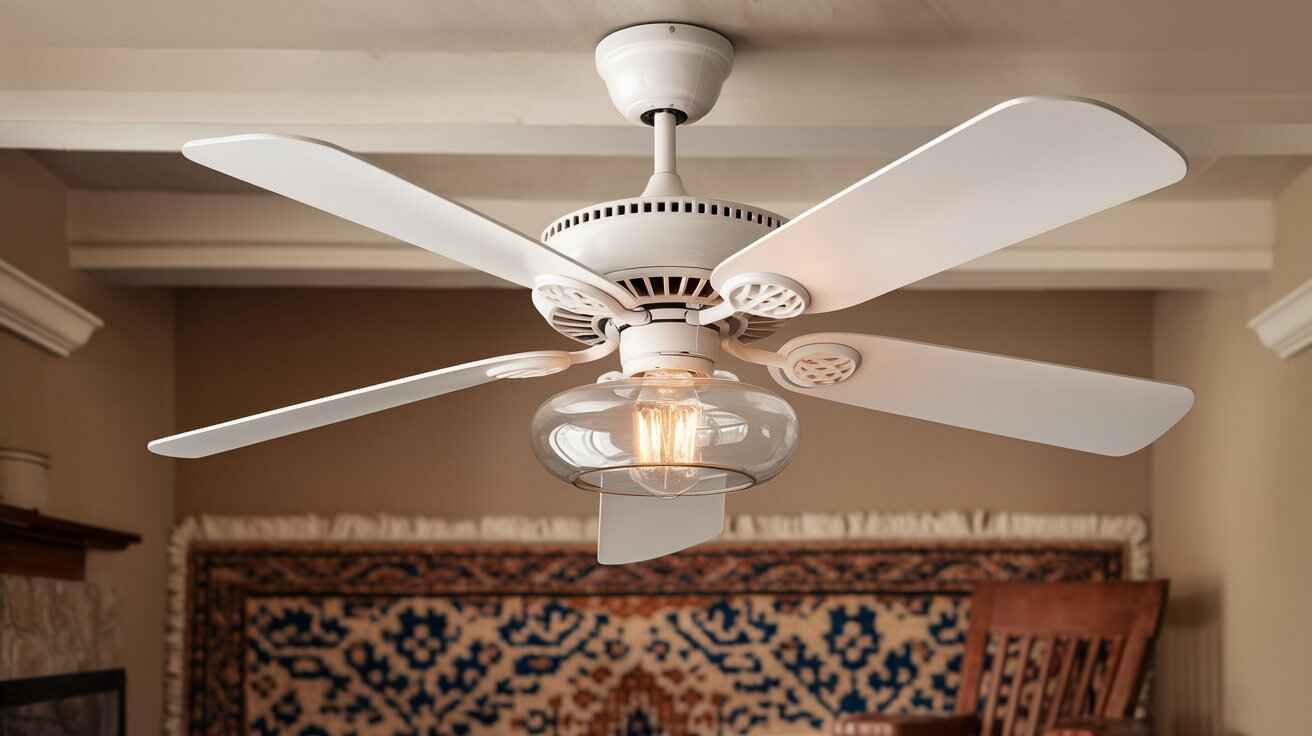Introduction
A ceiling fan with light offers cooling and illumination, enhancing comfort and saving area in any room. Ceiling fans with lighting fixtures combine two vital capabilities—airflow and lights—right into an unmarried fixture. This setup saves space and provides a modern-day contact in your room. With a wide variety of patterns, sizes, and electricity-efficient options to be had, ceiling fans with lighting fixtures are a clever choice for all of us trying to add convenience and luxury to our homes. In this manual, we’ll assist you explore the different types, functions, and blessings to discover the best fan for your wishes.
What is a Ceiling Fan with Light?
A ceiling fan with light is honestly a fan that includes an attached light fixture. This fan serves a dual purpose, offering air circulation and lighting. It is suitable for rooms in which you need each function; however, it won’t have enough ceiling space for separate furniture. These enthusiasts are available in numerous styles, from conventional to fashionable, to suit any domestic decor. They are particularly beneficial in small rooms or spaces where maximizing capability is vital.
Benefits of a Ceiling Fan with Light
Ceiling fans with lights offer several advantages. They keep the area by combining two features into one fixture, making them best for rooms with restricted ceiling vicinity. They can also help reduce strength expenses by enhancing airflow, allowing you to rely less on air conditioning. Many ceiling fanatics with lights include electricity-efficient LED lighting, which further reduces energy utilization. Additionally, they decorate the fashion and environment of a room, serving as both a decorative and purposeful detail.
Types of Ceiling Fan with Light
Numerous ceiling lovers have lights, each applicable for special room sizes and patterns.
- Standard Ceiling Fan: are versatile and work nicely in most rooms, providing the proper airflow and lighting fixtures.
- Low-Profile Ceiling Fan: Ideal for rooms with low ceilings, these lovers sit in the direction of the ceiling, maximizing headroom.
- Dual-Motor Ceiling Fan: These fanatics have adjustable units of blades, providing superior airflow and a unique appearance.
- Outdoor Ceiling Fan: Specifically designed for outdoor use, those are weather-resistant and secure for damp regions.
- Smart Ceiling Fan: Equipped with Wi-Fi, these lovers may be managed through apps or voice assistants, providing advanced comfort.
Energy Efficiency in Ceiling Fans with Lights
Energy-green lovers store money and reduce environmental impact.
- LED Lighting: LED lighting fixtures use much less strength than incandescent bulbs, presenting brilliant mild whilst saving energy. They also remain longer, decreasing the want for replacements.
- Energy Star Rating: Look for Energy Star-rated fans, as these are designed to consume less energy and meet strict strength performance pointers.
- Variable Speed Settings: Fans with adjustable speeds let you pick lower settings for slight days, which saves strength.
- Reverse Function: This function helps you exchange the route of the blades, circulating warm air in icy conditions and lowering heating charges.
- DC Motors: DC motor lovers use less power than standard AC automobiles, making them an extraordinary choice for strength savings.
Choosing the Right Style for Your Room
When choosing a ceiling fan, remember your room’s style.
- Modern Styles: Sleek and minimal designs with easy strains and neutral colorings match well in modern-day areas.
- Traditional Styles: Fans with timber finishes or ornate designs complement classic, traditional room decor.
- Rustic Styles: Often made with wood or metal finishes, these fans upload a comfy, herbal sense to a room.
- Industrial Styles: Typically offering steel finishes and formidable designs, commercial enthusiasts fit modern-day, urban interiors.
- Transitional Styles: Mixing classic and present-day elements, these lovers paint properly in versatile, combined-fashion homes.
Materials and Finishes
The material of a ceiling fan has mild impacts on its sturdiness and appearance.
- Metal Fans: Durable and easy to smooth, metallic enthusiasts paint properly in business or modern settings.
- Wooden Fans: Wooden blades add warmth and a natural appearance, becoming rustic or traditional decor.
- Plastic Blades: Lightweight and regularly used for outdoor enthusiasts due to their moisture resistance.
- Hybrid Finishes: Some lovers combine timber, metal, and glass, creating a balanced look that suits several styles.
- Brushed or Matte Finishes: These finishes lessen glare and add a graceful look, and they are best for minimalist and modern interiors.
Choosing the Right Size for Your Room
Selecting the proper length ceiling fan guarantees an effective air stream.
- Small Rooms (as much as 75 sq. Toes.): For top-of-the-line airflow, choose a fan with a blade span of 29–36 inches.
- Medium Rooms (76–144 sq. Ft.): A fan with a blade span of 36–42 inches is suitable for moderate-sized spaces.
- Large Rooms (a hundred forty-five–225 sq. Ft.): Look for lovers with a blade span of 52 inches or more.
- Extra-Large Rooms: For rooms over 225 sq. Feet. Consider a couple of fanatics or fans with a larger blade span, such as 60 inches.
- Outdoor Spaces: Outdoor fans often want to be significant in circulating air effectively in open spaces.
Control Options for Ceiling Fan with Light
Fan controls add comfort for your revel in.
- Pull Chain: A conventional alternative, but it can be hard to reach in rooms with high ceilings.
- Wall Control: This alternative allows you to govern the fan and light from a wall transfer. It is handy and smooth to use.
- Remote Control: Ideal for bedrooms or dwelling rooms, far-flung controls allow you to regulate settings from everywhere inside the room.
- Intelligent Controls: Wi-Fi-enabled enthusiasts can manage their devices via an app or voice commands, ideal for tech-savvy homes.
- Dual-Switch Control: Separates fan management and mild, permitting unbiased operation of each.

Blade Count and Blade Material
The quantity of blades and cloth can impact the fan’s performance and appearance.
- Number of Blades: Fans with fewer blades can circulate air more effectively, whilst more blades typically imply quieter operation.
- Metal Blades: Durable and perfect for humid areas, metal blades paint properly in industrial-fashion settings.
- Wood Blades: Often quieter, wooden blades are perfect for relaxed or rustic rooms.
- Plastic Blades: Lightweight and proof against moisture, making them a terrific choice for outside fanatics.
- Composite Materials: Some fans use composite blades, which are robust, lightweight, and resistant to warping.
Installing a Ceiling Fan with Light
Installing a ceiling fan with light can be an easy DIY undertaking if you’re comfortable with fundamental electric work.
- Preparation: Turn off the strength at the breaker and accumulate your tools.
- Mounting the Bracket: Install the fan’s mounting bracket to the ceiling.
- Wiring: Follow the producer’s instructions to cord the fan and mild correctly.
- Attaching the Fan Blades: Attach the fan blades securely to the motor.
- Testing the Fan: Once everything is in the area, activate the electricity to check the fan and mild.
Maintenance Tips
Maintaining your ceiling fan with light ensures a long lifespan.
- Cleaning Blades: Dust the blades frequently to prevent construction and preserve airflow.
- Checking for Wobbles: If the fan wobbles, take a look at the blades and screws for any looseness.
- Motor Care: Listen for unusual noises and lubricate the motor if necessary.
- Replacing Light Bulbs: Replace light bulbs as wanted using power-green LEDs.
- Inspecting Wiring: Periodically look into the wiring for put on or harm, mainly in older enthusiasts.
Outdoor Ceiling Fan with Light
For outdoor regions, pick out a fan that can withstand the climate.
- Damp-Rated Fans: Suitable for protected regions like porches.
- Wet-Rated Fans: Can deal with direct exposure to rain and moisture.
- UV-Resistant Materials: Choose materials that resist fading from
Common Mistakes to Avoid
Selecting and installing a ceiling fan with light may be a trustworthy procedure, but there are no unusual pitfalls to watch out for.
- Choosing the Wrong Size: Fans that are too big or too small for the room will not effectively circulate air received. Measure your area and choose the correct blade span to ensure efficiency.
- Ignoring Ceiling Height: For low ceilings, choose a flush-mount or low-profile fan. High ceilings might also require a download to place the fan at the appropriate peak for premier airflow.
- Overlooking Energy Efficiency: Forgetting to test for strength-green features like LED lighting fixtures or DC vehicles may result in higher utility bills.
- Not Balancing Blades Properly: Unbalanced blades can motivate wobbling and noise. Use a blade-balancing kit if wanted.
- Poor Installation: If you’re unsure about wiring, it’s safer to seek advice from a professional to avoid mishaps or short circuits.
Conclusion
Ceiling fanatics with lights deliver a realistic and stylish contact to any room, imparting comfort and comfort. From energy-saving options to decorative patterns that healthy any decor, those enthusiasts answer numerous wishes and tastes. Whether for indoor or outside use, choosing the proper ceiling fan with light entails considering the size, fashion, and unique functions that exceptionally fit your area. Proper preservation allows your fan to offer years of cushy airflow and lights, making it a precious addition to your property.
FAQs
Can I install a ceiling fan with light, or do I want an electrician?
If you’re comfortable with fundamental electric work, you may be capable of setting it up yourself. However, it is always best to rent an electrician for protection for complex installations or if you’re uncertain.
Are LED lighting fixtures in ceiling enthusiasts higher than conventional bulbs?
Yes, LED lighting is more robust, lasts longer, and produces less heat, making it a fantastic preference for ceiling fans with lights.
Can a ceiling fan with light be used on the exterior?
If it’s rated for outdoor use, damp-rated fans work for included areas, while wet-rated fans are safe for total exposure to rain and moisture.
How do I understand what length of fan to get for my room?
Measure the room and choose a fan with a blade span that suits the region. Small rooms want smaller fans, while massive rooms require large blade spans for effective airflow.
What is the advantage of a ceiling fan with a reverse function?
The opposite characteristic facilitates flow into warm air for the duration of less warm months, making it beneficial for 12-month-spherical consolation by pushing warm air down from the ceiling.
Also Read:Schumacher Battery Charger: Reliable Charging Solutions for All Vehicle Battery Types








2 Responses